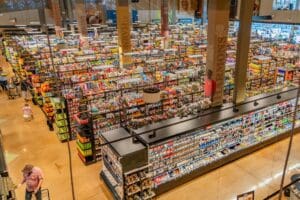
President Donald Trump’s decision to impose tariffs on imports from neighbouring Canada and Mexico has set off a trade war, sparking warnings about potential cost increases on a host of everyday items in the United States.
The White House maintains the tariffs will protect American industry, but critics argue they will simply inflate prices for US consumers. Here are six areas where tariffs could result in higher costs.
Cars
Car assembly in North America often involves components that cross US, Canadian and Mexican borders multiple times. With tariffs on imported parts, manufacturers are widely expected to pass extra costs on to buyers.
Estimated rise: TD Economics predicts car prices could jump by roughly $3,000 (£2,400). Tariffs disrupt decades of near-seamless trade in the automotive sector, which has previously kept prices relatively low.
Beer and spirits
Popular Mexican beers—such as Corona and Modelo—could become more expensive if importers opt to push increased import duties onto customers instead of scaling back supplies. Modelo became the number one beer brand in the US in 2023 and remains in the top spot, for now. This shift may affect millions of shoppers.
Spirits face a similar threat. Production of Bourbon, Tennessee whiskey, Canadian whisky and tequila is largely tied to their places of origin. If tariffs bite and cross-border costs climb, prices could rise for whiskey enthusiasts—and for anyone partial to a tequila-based tipple.
Houses
US home builders rely heavily on Canadian lumber, and new tariffs could push up the cost of materials. Given that most American homes are constructed with wood frames, higher lumber prices risk slowing construction, driving up home-buying costs and deterring developers from new building projects.
Maple syrup
Canadians produce about three-quarters of the world’s maple syrup, particularly in Quebec. With fresh tariffs looming on Canadian goods, imports may shrink or become costlier. Economists expect that the beloved breakfast staple will see a direct price rise—an unwelcome prospect for anyone who favours Canadian syrup on their pancakes.
Fuel prices
Canada is currently America’s largest foreign supplier of crude oil. While Canada faces a 10% tariff on its energy exports (compared to 25% on many other goods), any retaliatory move by Canada to reduce shipments of thicker “heavy” crude could raise pump prices. Many refineries in the US rely on such heavy crude to produce gasoline, diesel and jet fuel efficiently.
Avocados
Mexico’s warm climate supports large-scale avocado production, with roughly 90% of avocados consumed in the US originating south of the border. If tariffs push up import costs or reduce supply, the resulting avocado shortage could see a spike in prices—particularly noticeable during peak demand times like Super Bowl Sunday, when guacamole is practically compulsory for many American households.
While the US has suspended tariffs on Mexico for a month, taxes on Canadian goods are scheduled to come into force shortly. Both Canada and Mexico have threatened robust retaliation if negotiations fail, leaving consumers facing an uncertain future at the checkout. If price hikes and reduced imports do materialise, it may reveal just how integrated—and fragile—North America’s supply chains really are.
Read more:
Six things that Americans could be paying more for under Trump tariffs






